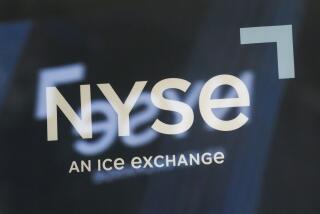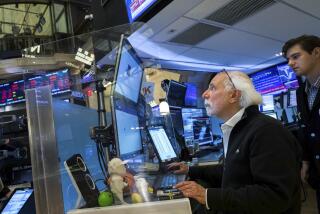Investors Are Turning Cool Toward ‘Junk Bond’ Issues
- Share via
The high-yield “junk bond” market is again showing why many investors consider it so risky.
Rising interest rates, worries about a slowing economy and a multibillion-dollar flood of new junk issues set to hit the market have pushed prices for many junk issues down as much as 2% to 3% in the past two weeks and 4% to 5% since the end of January.
Meanwhile, many junk bond mutual funds--one of the fastest-growing segments of the fund industry last year--are beginning to report small but noticeable net outflows of money as individual investors have become dissatisfied with recent performance and seek safer havens in money market funds or Treasury bills. Such outflows could grow as publicity about falling junk bond prices on Wall Street reaches more small investors on Main Street.
“Junk bond markets typically suffer from psychological excesses on the downside as well as the upside, and we seem to be in one of those periods,” said Richard S. Swingle, portfolio manager for T. Rowe Price High Yield Bond Fund, the top-performing mutual fund last year investing in junk bonds.
Whether this slump in the fast-growing $180-billion junk bond market is temporary or longer term remains to be seen. It certainly is not the first time the market has hit turbulence. An even worse slump occurred in the days following the October, 1987, stock market crash, as investors panicked and fled to top-quality government and corporate bonds, driving down junk bond prices sharply. But as recession fears subsided, the market subsequently recovered.
Indeed, on Friday, some higher quality junk issues--those with nearly “investment-grade” bond ratings--staged a mini-rally, recovering as much as 0.5% of their value, traders said.
But if that rally fades and the latest slump persists, it could have far-reaching consequences for the economy and Wall Street. It could dampen the recent wave of takeovers and leveraged buyouts financed by junk bonds and make it more difficult for many smaller companies to raise capital through junk issues. It also could accelerate the onset of a recession if junk jitters cause corporate executives and individuals to cool down their business and spending plans.
The slump, if it persists, could erode confidence in the already embattled investment firm of Drexel Burnham Lambert, the junk bond market’s top trader and cheerleader. Buyers say the slide has nothing to do with Drexel’s recent guilty plea to federal securities laws violations and its subsequent agreement to fire junk bond chief Michael Milken. But the firm--along with other major Wall Street firms--is taking some heat among bond buyers for not committing enough capital to maintain a high level of liquidity, or ease of buying and selling, in the market.
“The capital being committed by Wall Street firms to their trading desks to support the market is very small in relation to the amount of issues outstanding,” said Alan C. Petersen, senior vice president and portfolio manager for Cigna High Yield Bond Fund. “So there is not a lot of liquidity.”
“You would think with the broadening of the market with more retail clients (such as mutual funds), that would add to liquidity,” added C. Richard Lehmann, president of the Bond Investors Assn. in Miami.
Inflation Jitters
Aggravating that lack of liquidity, market players say, is the prospect of some $9 billion in new junk issues expected to hit the market in coming few weeks, led by a record $5-billion issue to help finance the takeover of RJR Nabisco. Many of these issues are being underwritten by Drexel.
Fears of an increase in bond defaults in a recession--due to corporations being unable to make debt payments as revenue and profit decline--also is contributing to the slump. Conventional wisdom holds that the rate of junk bond defaults could rise to between 5% and 10% in a recession, up from about 2% now. Higher yields, however, could offset all or part of any defaults in a diversified portfolio of junk issues.
But a new unpublished study by a Harvard University professor and two others, publicized this week, suggests that the actual default rate has been much higher. It contended that investors who bought and held a portfolio of all the junk bonds issued in 1977 and 1978 would, 10 years later, have suffered a default rate of 34%.
While many traders said the study had little or no impact on market prices--and others dismissed it--it did cause an uneasy stir on Wall Street.
Also causing uneasiness this week was some concern that Solomon Asset Management, an investment management firm, might be forced to sell its huge portfolio of junk bonds to meet cash demands from nervous pension clients. Company founder David B. Solomon is leaving the firm because he is cooperating in the federal government’s probe of Milken and Drexel.
Issues said to be hardest hit by price declines include those of retailers, such as Carter Hawley Hale and Federated Department Stores, and those of building supply firms. Both sectors would be hurt more than the market as a whole in a recession, analysts said.
Spreads Widening
Also hit are some issues of firms that have undergone large leveraged buyouts, such as Southland and Interco. Traders are concerned that these firms will have trouble selling assets to meet debt payments, as higher interest rates are making it more difficult for potential buyers of these assets to finance purchases.
Declines in these and other junk issues have been reflected in widening “spreads” between yields on junk issues and Treasury issues of comparable maturities. These spreads were below 4 percentage points about a month ago but lately have risen to close to 5 points, the same level following the October, 1987, stock market crash.
These price declines have dampened the performance of mutual funds investing in junk bonds. The funds on average rose only 1.78% in the first quarter, after rising 8.46% last year. That has helped prompt investor withdrawals from several funds.
The T. Rowe Price High Yield Bond Fund, for example, has experienced a small but noticeable drop of just under 2% of its assets, spokesman Steven Norwitz said Friday.
“Investors are getting a little jittery,” Norwitz said, noting that while junk funds are offering yields of 12.5% or more, erosion of bond prices can wipe out part of that gain. Money market funds, on the other hand, are paying more than 9.5% with virtually no risk to principal.
“That’s a pretty attractive safety net for people concerned about volatility in their principal,” Norwitz said.
More to Read
Inside the business of entertainment
The Wide Shot brings you news, analysis and insights on everything from streaming wars to production — and what it all means for the future.
You may occasionally receive promotional content from the Los Angeles Times.










